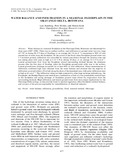| dc.contributor.author | Ramberg, L. | |
| dc.contributor.author | Wolski, P. | |
| dc.contributor.author | Krah, M. | |
| dc.date.accessioned | 2013-12-07T12:29:08Z | |
| dc.date.available | 2013-12-07T12:29:08Z | |
| dc.date.issued | 2006 | |
| dc.identifier.citation | Ramberg, L. et.al (2006) Water balance and infiltration in a seasonal floodplain in the Okavango Delta, Botswana. Wetlands, vol. 26,. no. 3, pp. 677-690. | en_US |
| dc.identifier.uri | http://hdl.handle.net/10311/1196 | |
| dc.description | Some symbols on the abstract may not appear as in the original document. | en_US |
| dc.description.abstract | Water balance in a seasonal floodplain in the Okavango Delta, Botswana was determined for three years (1997–1999). There was no surface outflow, and infiltration to ground water was very large (4.7–9.7 m during 90–175 days of flooding, or on average 4.6–5.4 cm·d−), amounting to 90% of total annual loss of water from the floodplain. At the arrival of the flood, when floodplain ground water was 3–5 m below ground, infiltration was controlled by vertical percolation through the aeration zone and was taking place with rates as high as 1.11–1.74 m during 10 days, or on average 11.1–17.4 cm·d−1. Lateral ground-water flow from the floodplain toward surrounding dryland became the dominant process after the first days of flooding, when the floodplain ground-water table rose to the surface. Lateral ground-water drainage accounted for at least 80% of total infiltration. Direct measurements of infiltration confirmed high rates obtained from the water balance and revealed that the majority of infiltration occurred within a 10-m belt along the shore of the inundated area, with point infiltration rates as high as 42 cm·d−1. The infiltration values are high compared to other large recharge wetlands (e.g., the Everglades, the Hadejia-Nguru) and result from a combination of lack of a low permeability surface layer in the floodplain and strong drainage of floodplain ground water driven by evaporation from the surrounding drylands. High infiltration and lateral ground-water flows have major implications for the Okavango Delta ecology, as they provide water to riparian vegetation, affect floodplain nutrient balance, and are part of the process responsible for immobilization of dissolved minerals. | en_US |
| dc.language.iso | en | en_US |
| dc.publisher | Springer link, http://link.springer.com | en_US |
| dc.subject | Water balance | en_US |
| dc.subject | Infiltration | en_US |
| dc.subject | Groundwater | en_US |
| dc.subject | Seasonal wetland | en_US |
| dc.subject | Flood | en_US |
| dc.title | Water balance and infiltration in a seasonal floodplain in the Okavango Delta, Botswana | en_US |
| dc.type | Published Article | en_US |
| dc.link | http://link.springer.com/article/10.1672/0277-5212(2006)26%5B677:WBAIIA%5D2.0.CO%3B2# | en_US |

